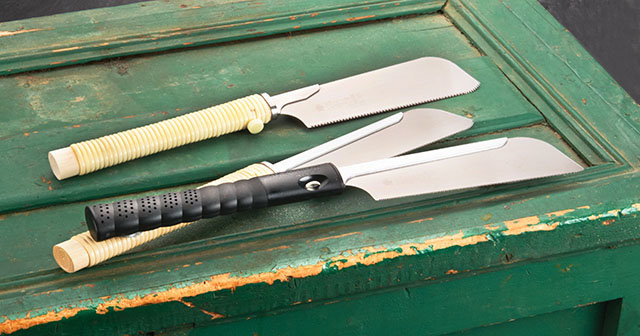Introducing: Japanese Hand Tools
You will find that Japanese hand tools have different characteristics to Western Hand tools.
The tools that are primarily used in Japanese woodwork and joinery are: Planers, Chisels, Saws and Honing Stones.

Japanese Planers have a wooden Body which is fashioned out of a Oak species called Kashi or Stone Oak (Quercus Myrsinaefolia ). Blade angle of the planer is determined depending on the hardness of the wood in your project. The Softer the wood, the lower the angle of the blade, the harder the wood, the higher the blade. Japanese planers also have a clipper behind the blade, this concept could have been adopted from Europe. The blade has 2 layers of steel. The bottom part only a few millimetres thick, is made of hard steel and becomes the Edge of the planer. The top part is made from soft steel. The cutting edge is always at the bottom end, the rest of the blade does not affect the cutting ability.

Japanese Chisels have 2 layers of steel like that of the Japanese Planer, they also have thumb dents and usually required some set up which is called Shikomi. The chisel blade angle is set at a certain angle so that the wood handle end does not interfere with the work surface. At the end on the chisel handle there is a crown fixed, which will prevent the wooden handle end from crumbling. When a new chisel is bought, the crown might be too tight to push over the handle, it is sometimes necessary to file the crown id to enlarge it slightly and to round the corners. The crown must slide down along the handle as the top of the handle wears, if the crown cuts into the handle, the chisel starts to bounce when hammered.

The Japanese Saw is a much thinner saw than western saws and are made to pull when cutting. Cross cutting saws have slightly more complicated tooth configurations than longitudinal cutting saws, with larger tooth sizes towards the far end. Small teeth are for more finer work.
And lastly the honing stone also an integral part of the Japanese carpenter’s toolkit, before sharpening blades we must make sure that the Japanese honing stone has a flat surface.
Honing stone must be soaked in water 30min before use, when sharpening blades slurry remains on the surface which tends to make the blade slip over the stone, resulting in the blade not being sharpened, remove slurry after every 100th lap to retain abrasiveness.
Tools4Wood are able to accommodate any request related to an associated product. Please browse through our online catalogue.

Comments
Add comment